Impact of Urbanization on Ecosystem Services Balance in the Han River Ecological Economic Belt, China: A Multi-Scale Perspective
Abstract
1. Introduction
2. Materials and Methods
2.1. Study Area
2.2. Data Sources and Processing
2.3. ESs Balance Index Assessment
2.4. Spatial Autocorrelation Analysis
2.5. Geographically Weighted Regression Model
3. Results
3.1. Spatiotemporal Patterns of ESs in the HREEB
3.2. Spatiotemporal Patterns of the Urbanization Level in the HREEB
3.3. Bivariate Spatial Autocorrelation Analysis
3.4. Spatially Varying Relationships
4. Discussion
4.1. Impact of Urbanization Elements on ESs Balance Index
4.2. Policy Implications
- (1)
- Based on the results for the S&D of ESs and the balance between them, the deficit and surplus areas of ESs can be identified. Different ecological function zones can be defined according to the S&D of ESs, and the dominant functions can be clearly defined. The balance between the S&D of ESs in HREEB can be achieved by complementing the regional functions. This process can achieve a balance between the S&D of ESs through the spatial flow of ESs. In addition, the balance of regional ESs can be achieved by increasing the supply of ESs or reducing the demand for ESs. For the key urbanization region, the demand capacity of ESs was strong, but the supply capacity of ESs was weak. Therefore, the deficit of ESs in the key urbanization region needs to be balanced in regard to the whole HREEB region or a larger region [39]. The boundary restrictions of administrative regions need to be broken, and collaborative governance of ecosystems among regions needs to be achieved [33].
- (2)
- According to the spatial non-stationarity characteristics of the impact of urbanization on the ESBI, suggestions can be made to alleviate the trade-off between them. In areas where urbanization had a serious impact on the ESBI, full attention should be paid to alleviating population and economic pressure, and the red line of arable land and ecological land should be adhered to, ensuring the balance between the grain S&D was achieved, and the demand for ecological land was met. It is suggested that the ecological corridors between surplus and deficit regions of the ESs S&D should be optimized, and a regional ecological security pattern should be built in the HREEB [39,69].
- (3)
- In addition, cooperation between regions within the HREEB should be strengthened to build a perfect ecological compensation mechanism. The ecological compensation mechanism can guarantee the source of funds for ecological protection, and it can also force the transformation and upgrading of industries [70,71,72]. At present, the compensation mechanism has not been fully implemented in the Han River basin, and the ecological compensation standards in the upstream and downstream transboundary areas are unclear. The Hubei Provincial Government has issued relevant documents to support local governments in the Han River Basin to establish a horizontal compensation mechanism for ecological protection and increase support for transfer payments to key ecological function zones, major agricultural production areas, and poverty-stricken areas.
- (4)
- At present, the contradiction between accelerating economic growth and strengthening ecological protection is prominent in the HREEB. HREEB ecological protection can be based on the different functions of the upper, middle, and lower reaches of the region and the different geographical conditions and climatic disturbance, combined with the characteristics of the ESs S&D. In terms of agricultural development, it was suggested that a modern agricultural operation system should be built, the support for agricultural modernization should be strengthened, eco-friendly agriculture should be vigorously developed, the construction of modern agricultural demonstration zones should be accelerated, and our ability to ensure food security should be enhanced.
4.3. Limitations and Prospects
5. Conclusions
- (1)
- During the study period, the ESSI and ESDI of the HREEB increased, while the ESBI showed a decreasing trend. Overall, we found that the ESSI and ESBI were significantly higher in mountain areas than in plain areas, and on the contrary, the ESDI was higher in plain areas than in mountain areas.
- (2)
- The urbanization level of the HREEB improved during the study period. Generally, we found that the urbanization level in the middle and lower reaches of the Han River was higher than that in the Danjiangkou Reservoir area and the upper reaches of the Han River.
- (3)
- There was a significant spatial autocorrelation between urbanization and the ESBI. High–low (high urbanization level–low ESBI) and low–high (low urbanization level–high ESBI) types were the main relationship types identified between urbanization elements and the ESBI in the HREEB during the study period.
- (4)
- The GWR model can model the multi-scale spatial relationship between urbanization factors and the ESBI well. We found that the impact of urbanization factors on the ESBI can be positive or negative, but it varies significantly in space.
Author Contributions
Funding
Institutional Review Board Statement
Informed Consent Statement
Data Availability Statement
Conflicts of Interest
References
- Friedmann, J. Four theses in the study of China’s urbanization. Int. J. Urban. Regional. 2006, 30, 440–451. [Google Scholar] [CrossRef]
- Weng, Y. Spatiotemporal changes of landscape pattern in response to urbanization. Landsc. Urban Plan. 2007, 81, 341–353. [Google Scholar] [CrossRef]
- Zhai, T.; Wang, J.; Jin, Z.; Qi, Y.; Liu, J. Did improvements of ecosystem services supply-demand imbalance change environmental spatial injustices? Ecol. Indic. 2020, 111, 106068. [Google Scholar] [CrossRef]
- Wang, J.; Zhai, T.; Lin, Y.; Kong, S.; He, T. Spatial imbalance and changes in supply and demand of ecosystem services in China. Sci. Total Environ. 2019, 657, 781–791. [Google Scholar] [CrossRef] [PubMed]
- Chen, W.; Chi, G. Urbanization and ecosystem services: The multi-scale spatial spillover effects and spatial variations. Land Use Policy 2022, 114, 105964. [Google Scholar] [CrossRef]
- Tian, Y.; Jiang, G.; Zhou, D.; Li, G. Systematically addressing the heterogeneity in the response of ecosystem services to agricultural modernization, industrialization and urbanization in the Qinghai-Tibetan plateau from 2000 to 2018. J. Clean. Prod. 2021, 285, 125323. [Google Scholar] [CrossRef]
- Ouyang, X.; Tang, L.; Wei, X.; Li, Y. Spatial interaction between urbanization and ecosystem services in Chinese urban agglomerations. Land Use Policy 2021, 109, 105587. [Google Scholar] [CrossRef]
- Chen, W.; Chi, G. Ecosystem services trade-offs and synergies in China, 2000–2015. Int. J. Environ. Sci. Technol. 2022, 1–16. [Google Scholar] [CrossRef]
- Li, S.; Zhao, Y.; Xiao, W.; Yellishetty, M.; Yang, D. Identifying ecosystem service bundles and the spatiotemporal characteristics of trade-offs and synergies in coal mining areas with a high groundwater table. Sci. Total Environ. 2022, 807, 151036. [Google Scholar] [CrossRef]
- Liu, C.; Xu, Y.; Lu, X.; Han, J. Trade-offs and driving forces of land use functions in ecologically fragile areas of Northern Hebei Province: Spatiotemporal analysis. Land Use Policy 2021, 104, 105387. [Google Scholar] [CrossRef]
- Shen, J.; Li, S.; Liang, Z.; Wang, Y.; Sun, F. Research progress and prospect for the relationships between ecosystem services supplies and demands. J. Nat. Res. 2021, 36, 1909–1922. [Google Scholar] [CrossRef]
- Jiang, M.; Jiang, C.; Huang, W.; Chen, W.; Gong, Q.; Yang, J.; Zhao, Y.; Zhuang, C.; Wang, J.; Yang, Z. Quantifying the supply-demand balance of ecosystem services and identifying its spatial determinants: A case study of ecosystem restoration hotspot in Southwest China. Ecol. Eng. 2022, 174, 106472. [Google Scholar] [CrossRef]
- Xu, Z.; Peng, J.; Dong, J.; Liu, Y.; Liu, Q.; Lyu, D.; Qiao, R.; Zhang, Z. Spatial correlation between the changes of ecosystem service supply and demand: An ecological zoning approach. Landsc. Urban Plan. 2022, 217, 104258. [Google Scholar] [CrossRef]
- Liu, W.; Zhan, J.; Zhao, F.; Zhang, F.; Teng, Y.; Wang, C.; Chu, X.; Kumi, M.A. The tradeoffs between food supply and demand from the perspective of ecosystem service flows: A case study in the Pearl River Delta, China. J. Environ. Manage. 2022, 301, 113814. [Google Scholar] [CrossRef]
- Sun, X.; Tang, H.; Yang, P.; Hu, G.; Liu, Z.; Wu, J. Spatiotemporal patterns and drivers of ecosystem service supply and demand across the conterminous United States: A multiscale analysis. Sci. Total Environ. 2020, 703, 135005. [Google Scholar] [CrossRef]
- Liu, R.; Dong, X.; Wang, X.; Zhang, P.; Liu, M.; Zhang, Y. Study on the relationship among the urbanization process, ecosystem services and human well-being in an arid region in the context of carbon flow: Taking the manas river basin as an example. Ecol. Indic. 2021, 132, 108248. [Google Scholar] [CrossRef]
- Dong, X.; Ren, J.; Zhang, P.; Jin, Y.; Liu, R.; Wang, X.; Lee, C.T.; Klemeš, J.J. Entwining ecosystem services, land use change and human well-being by nitrogen flows. J. Clean. Prod. 2021, 308, 127442. [Google Scholar] [CrossRef]
- Huang, Q.; Yin, D.; He, C.; Yan, J.; Liu, Z.; Meng, S.; Ren, Q.; Zhao, R.; Inostroza, L. Linking ecosystem services and subjective well-being in rapidly urbanizing watersheds: Insights from a multilevel linear model. Ecosyst. Serv. 2020, 43, 101106. [Google Scholar] [CrossRef]
- Sun, Y.; Liu, D.; Wang, P. Urban simulation incorporating coordination relationships of multiple ecosystem services. Sustain. Cities Soc. 2022, 76, 103432. [Google Scholar] [CrossRef]
- Xu, Q.; Yang, R.; Zhuang, D.; Lu, Z. Spatial gradient differences of ecosystem services supply and demand in the Pearl River Delta region. J. Clean. Prod. 2021, 279, 123849. [Google Scholar] [CrossRef]
- Chen, W.; Chi, G. Spatial mismatch of ecosystem service demands and supplies in China, 2000–2020. Environ. Monit. Assess. 2022, 194, 295. [Google Scholar] [CrossRef] [PubMed]
- Xing, L.; Zhu, Y.; Wang, J. Spatial spillover effects of urbanization on ecosystem services value in Chinese cities. Ecol. Indic. 2021, 121, 107028. [Google Scholar] [CrossRef]
- Liao, J.; Yu, C.; Feng, Z.; Zhang, H.; Wu, K.; Ma, X. Spatial differentiation characteristics and driving factors of agricultural eco-efficiency in Chinese provinces from the perspective of ecosystem services. J. Clean. Prod. 2021, 288, 125466. [Google Scholar] [CrossRef]
- Yee, S.H.; Paulukonis, E.; Simmons, C.; Russell, M.; Fulford, R.; Harwell, L.; Smith, L.M. Projecting effects of land use change on human well-being through changes in ecosystem services. Ecol. Model. 2021, 440, 109358. [Google Scholar] [CrossRef]
- Yu, H.; Xie, W.; Sun, L.; Wang, Y. Identifying the regional disparities of ecosystem services from a supply-demand perspective. Resour. Conserv. Recy. 2021, 169, 105557. [Google Scholar] [CrossRef]
- Cao, T.; Yi, Y.; Liu, H.; Xu, Q.; Yang, Z. The relationship between ecosystem service supply and demand in plain areas undergoing urbanization: A case study of China’s Baiyangdian Basin. J. Environ. Manag. 2021, 289, 112492. [Google Scholar] [CrossRef]
- Dai, X.; Wang, L.; Tao, M.; Huang, C.; Sun, J.; Wang, S. Assessing the ecological balance between supply and demand of blue-green infrastructure. J. Environ. Manag. 2021, 288, 112454. [Google Scholar] [CrossRef]
- Zhang, Z.; Peng, J.; Xu, Z.; Wang, X.; Meersmans, J. Ecosystem services supply and demand response to urbanization: A case study of the Pearl River Delta, China. Ecosyst. Serv. 2021, 49, 101274. [Google Scholar] [CrossRef]
- Deng, C.; Liu, J.; Liu, Y.; Li, Z.; Nie, X.; Hu, X.; Wang, L.; Zhang, Y.; Zhang, G.; Zhu, D.; et al. Spatiotemporal dislocation of urbanization and ecological construction increased the ecosystem service supply and demand imbalance. J. Environ. Manag. 2021, 288, 112478. [Google Scholar] [CrossRef]
- Pan, Z.; Wang, J. Spatially heterogeneity response of ecosystem services supply and demand to urbanization in China. Ecol. Eng. 2021, 169, 106303. [Google Scholar] [CrossRef]
- Chen, W.; Bian, J.; Liang, J.; Pan, S.; Zeng, Y. Traffic accessibility and the coupling degree of ecosystem services supply and demand in the middle reaches of the Yangtze River urban agglomeration, China. J. Geogr. Sci. 2022, 32, 1471–1492. [Google Scholar] [CrossRef]
- Khosravi-Mashizi, A.; Sharafatmandrad, M. Investigating tradeoffs between supply, use and demand of ecosystem services and their effective drivers for sustainable environmental management. J. Environ. Manag. 2021, 289, 112534. [Google Scholar] [CrossRef] [PubMed]
- Chen, W.; Chi, G.; Li, J. The spatial aspect of ecosystem services balance and its determinants. Land Use Policy 2020, 90, 104263. [Google Scholar] [CrossRef]
- Burkhard, B.; Kroll, F.; Nedkov, S.; Müller, F. Mapping ecosystem service supply, demand and budgets. Ecol. Indic. 2012, 21, 17–29. [Google Scholar] [CrossRef]
- Sun, Y.; Liu, S.; Dong, Y.; An, Y.; Shi, F.; Dong, S.; Liu, G. Spatio-temporal evolution scenarios and the coupling analysis of ecosystem services with land use change in China. Sci. Total Environ. 2019, 681, 211–225. [Google Scholar] [CrossRef]
- Sun, R.; Jin, X.; Han, B.; Liang, X.; Zhang, X.; Zhou, Y. Does scale matter? Analysis and measurement of ecosystem service supply and demand status based on ecological unit. Environ. Impact Asses. 2022, 95, 106785. [Google Scholar] [CrossRef]
- Wang, C.; Wang, L.; Zhan, J.; Liu, W.; Teng, Y.; Chu, X.; Wang, H. Spatial heterogeneity of urbanization impacts on ecosystem services in the urban agglomerations along the Yellow River, China. Ecol. Eng. 2022, 182, 106717. [Google Scholar] [CrossRef]
- Peng, J.; Wang, X.; Liu, Y.; Zhao, Y.; Xu, Z.; Zhao, M.; Qiu, S.; Wu, J. Urbanization impact on the supply-demand budget of ecosystem services: Decoupling analysis. Ecosyst. Serv. 2020, 44, 101139. [Google Scholar] [CrossRef]
- Yang, Y.; Li, J.; Wang, L.; Wang, Z.; Yao, C.; Wang, Y. Impact of urbanization on supply and demand of typical ecosystem services in Yangtze River Delta. J. Nat. Res. 2022, 37, 1555–1571. [Google Scholar] [CrossRef]
- Chen, L.; Gong, J.; Wang, X.; Zheng, X. Spatial relationship between ecosystem services balance and urbanization in the middle reaches of the Yangtze River. Acta Ecol. Sin. 2021, 41, 5546–5556. [Google Scholar] [CrossRef]
- Gu, C. Urbanization: Positive and Negative Effects. Sci. Bull. 2019, 64, 281–283. [Google Scholar] [CrossRef]
- Yu, Q.; Feng, C.; Shi, Y.; Guo, L. Spatiotemporal interaction between ecosystem services and urbanization in china: Incorporating the scarcity effects. J. Clean. Prod. 2021, 317, 128392. [Google Scholar] [CrossRef]
- Bai, L.; Xiu, C.; Feng, X.; Liu, D. Influence of urbanization on regional habitat quality: A case study of Changchun City. Habitat Int. 2019, 93, 102042. [Google Scholar] [CrossRef]
- Tian, Y.; Zhou, D.; Jiang, G. Conflict or coordination? Multiscale assessment of the spatio-temporal coupling relationship between urbanization and ecosystem services: The case of the Jingjinji region, China. Ecol. Indic. 2020, 117, 106543. [Google Scholar] [CrossRef]
- Lapointe, M.; Gurney, G.G.; Cumming, G.S. Urbanization alters ecosystem service preferences in a small island developing state. Ecosyst. Serv. 2020, 43, 101109. [Google Scholar] [CrossRef]
- Zhou, Z. Conceptual mechanism model of impact of urbanization on ecosystem service and case study. Res. Soil. Water Conserv. 2011, 18, 32–38. [Google Scholar] [CrossRef]
- Richards, D.R.; Law, A.; Tan, C.S.Y.; Shaikh, S.F.E.A.; Carrasco, L.R.; Jaung, W.; Oh, R.R.Y. Rapid urbanisation in Singapore causes a shift from local provisioning and regulating to cultural ecosystem services use. Ecosyst. Serv. 2020, 46, 101193. [Google Scholar] [CrossRef]
- Wu, X.; Liu, S.; Zhao, S.; Hou, X.; Xu, J.; Dong, S.; Liu, G. Quantification and driving force analysis of ecosystem services supply, demand and balance in China. Sci. Total Environ. 2019, 652, 1375–1386. [Google Scholar] [CrossRef]
- Shi, Y.; Feng, C.; Yu, Q.; Guo, L. Integrating supply and demand factors for estimating ecosystem services scarcity value and its response to urbanization in typical mountainous and hilly regions of south China. Sci. Total. Environ. 2021, 796, 149032. [Google Scholar] [CrossRef]
- Chen, W.; Zeng, J.; Li, N. Change in land-use structure due to urbanisation in China. J. Clean. Prod. 2021, 321, 128986. [Google Scholar] [CrossRef]
- Chen, W.; Zeng, Y.; Zeng, J. Impacts of traffic accessibility on ecosystem services: An integrated spatial approach. J. Geogr. Sci. 2021, 31, 1816–1836. [Google Scholar] [CrossRef]
- Chen, W.; Liu, Z.; Li, J.; Ren, D.; Zeng, J. Mapping the spatial relationship between ecosystem services and urbanization in the middle reaches of the Yangtze River Urban Agglomerations. Acta Ecol. Sin. 2020, 40, 5137–5150. [Google Scholar] [CrossRef]
- Burkhard, B.; Kandziora, M.; Hou, Y.; Müller, F. Ecosystem service potentials, flows and demands–concepts for spatial localisation, indication and quantification. Landsc. Online 2014, 34, 1–32. [Google Scholar] [CrossRef]
- Chen, W.; Gu, T.; Zeng, J. Urbanisation and ecosystem health in the middle reaches of the Yangtze river urban agglomerations, China: A u-curve relationship. J. Environ. Manag. 2022, 318, 115565. [Google Scholar] [CrossRef]
- Li, W.; Sun, W.; Li, G.; Jin, B.; Wu, W.; Cui, P.; Zhao, G. Transmission mechanism between energy prices and carbon emissions using geographically weighted regression. Energ. Policy 2018, 115, 434–442. [Google Scholar] [CrossRef]
- Su, S.; Xiao, R.; Zhang, Y. Multi-scale analysis of spatially varying relationships between agricultural landscape patterns and urbanization using geographically weighted regression. Appl. Geogr. 2012, 32, 360–375. [Google Scholar] [CrossRef]
- Su, S.; Li, D.; Hu, Y.; Xiao, R.; Zhang, Y. Spatially non-stationary response of ecosystem service value changes to urbanization in Shanghai, China. Ecol. Indic. 2014, 45, 332–339. [Google Scholar] [CrossRef]
- Chen, W.; Chi, G.; Li, J. The Spatial Association of Ecosystem Services with Land Use and Land Cover Change at the County Level in China, 1995–2015. Sci. Total. Environ. 2019, 669, 459–470. [Google Scholar] [CrossRef]
- Zhu, C.; Zhang, X.; Zhou, M.; He, S.; Gan, M.; Yang, L.; Wang, K. Impacts of urbanization and landscape pattern on habitat quality using OLS and GWR models in Hangzhou, China. Ecol. Indic. 2020, 117, 106654. [Google Scholar] [CrossRef]
- Zhang, T.; Gong, W.; Wang, W.; Ji, Y.; Zhu, Z.; Huang, Y. Ground level PM2.5 estimates over china using satellite-based geographically weighted regression (GWR) models are improved by including NO2 and enhanced vegetation index (EVI). Int. J. Environ. Res. Public Health 2016, 13, 1215. [Google Scholar] [CrossRef]
- Deng, C.; Liu, J.; Nie, X.; Li, Z.; Liu, Y.; Xiao, H.; Hu, X.; Wang, L.; Zhang, Y.; Zhang, G.; et al. How trade-offs between ecological construction and urbanization expansion affect ecosystem services. Ecol. Indic. 2021, 122, 107253. [Google Scholar] [CrossRef]
- Li, G.; Fang, C.; Li, Y.; Wang, Z.; Sun, S.; He, S.; Qi, W.; Bao, C.; Ma, H.; Fan, Y.; et al. Global impacts of future urban expansion on terrestrial vertebrate diversity. Nat. Commun. 2022, 13, 1628. [Google Scholar] [CrossRef] [PubMed]
- Li, W.; Xie, S.; Wang, Y.; Huang, J.; Cheng, X. Effects of urban expansion on ecosystem health in southwest china from a multi-perspective analysis. J. Clean. Prod. 2021, 294, 126341. [Google Scholar] [CrossRef]
- Zheng, Z.; Qingyun, H. Spatio-temporal evaluation of the urban agglomeration expansion in the Middle Reaches of the Yangtze River and its impact on ecological lands. Sci. Total. Environ. 2021, 790, 148150. [Google Scholar] [CrossRef]
- Puplampu, D.A.; Boafo, Y.A. Exploring the impacts of urban expansion on green spaces availability and delivery of ecosystem services in the Accra Metropolis. Environ. Challenges 2021, 5, 100283. [Google Scholar] [CrossRef]
- Mao, D.; Wang, Z.; Wu, J.; Wu, B.; Zeng, Y.; Song, K.; Yi, K.; Luo, L. China’s wetlands loss to urban expansion. Land Degrad. Dev. 2018, 29, 2644–2657. [Google Scholar] [CrossRef]
- Ke, X.; van-Vliet, J.; Zhou, T.; Verburg, P.H.; Zheng, W.; Liu, X. Direct and indirect loss of natural habitat due to built-up area expansion: A model-based analysis for the city of Wuhan, China. Land Use Policy 2018, 74, 231–239. [Google Scholar] [CrossRef]
- Lu, Y.; Zhang, Y. Research on Coupling Coordination Development of Traffic Condition-Regional Economy-Ecological Environment in Hanjiang River Ecological Economy Belt. Resour. Environ. Yangtze Basin 2022, 1–19. Available online: https://kns.cnki.net/kcms/detail/42.1320.X.20220919.1241.002.html (accessed on 30 September 2022).
- Guan, Q.; Hao, J.; Ren, G.; Li, M.; Chen, A.; Duan, W.; Chen, H. Ecological indexes for the analysis of the spatial–temporal characteristics of ecosystem service supply and demand: A case study of the major grain-producing regions in Quzhou, China. Ecol. Indic. 2020, 108, 105748. [Google Scholar] [CrossRef]
- Zhai, T.; Zhang, D.; Zhao, C. How to optimize ecological compensation to alleviate environmental injustice in different cities in the yellow river basin? A case of integrating ecosystem service supply, demand and flow. Sustain. Cities. Soc. 2021, 75, 103341. [Google Scholar] [CrossRef]
- Su, K.; Sun, X.; Guo, H.; Long, Q.; Li, S.; Mao, X.; Niu, T.; Yu, Q.; Wang, Y.; Yue, D. The establishment of a cross-regional differentiated ecological compensation scheme based on the benefit areas and benefit levels of sand-stabilization ecosystem service. J. Clean. Prod. 2020, 270, 122490. [Google Scholar] [CrossRef]
- Fan, M.; Chen, L. Spatial characteristics of land uses and ecological compensations based on payment for ecosystem services model from 2000 to 2015 in Sichuan Province, China. Ecol. Inform. 2019, 50, 162–183. [Google Scholar] [CrossRef]
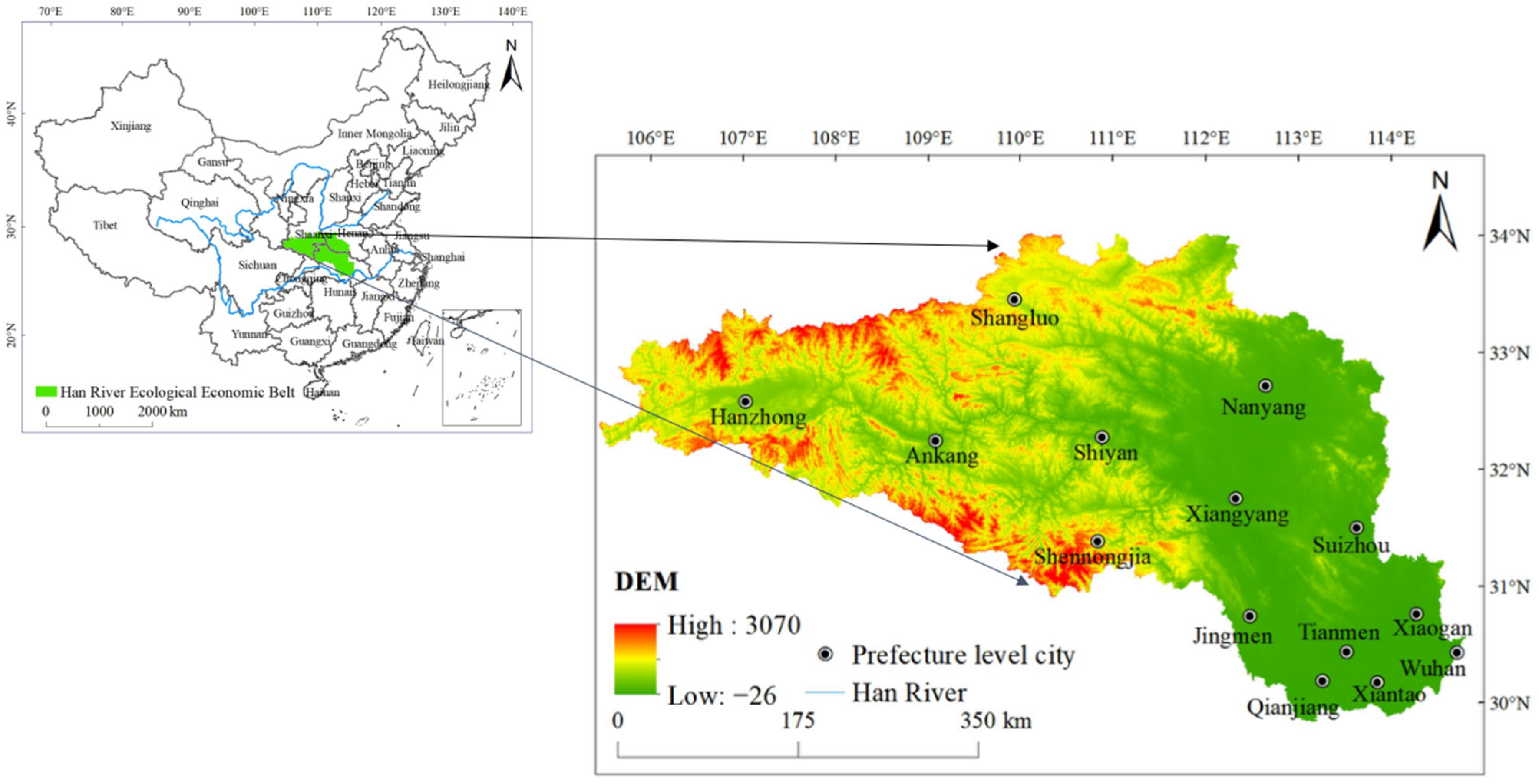
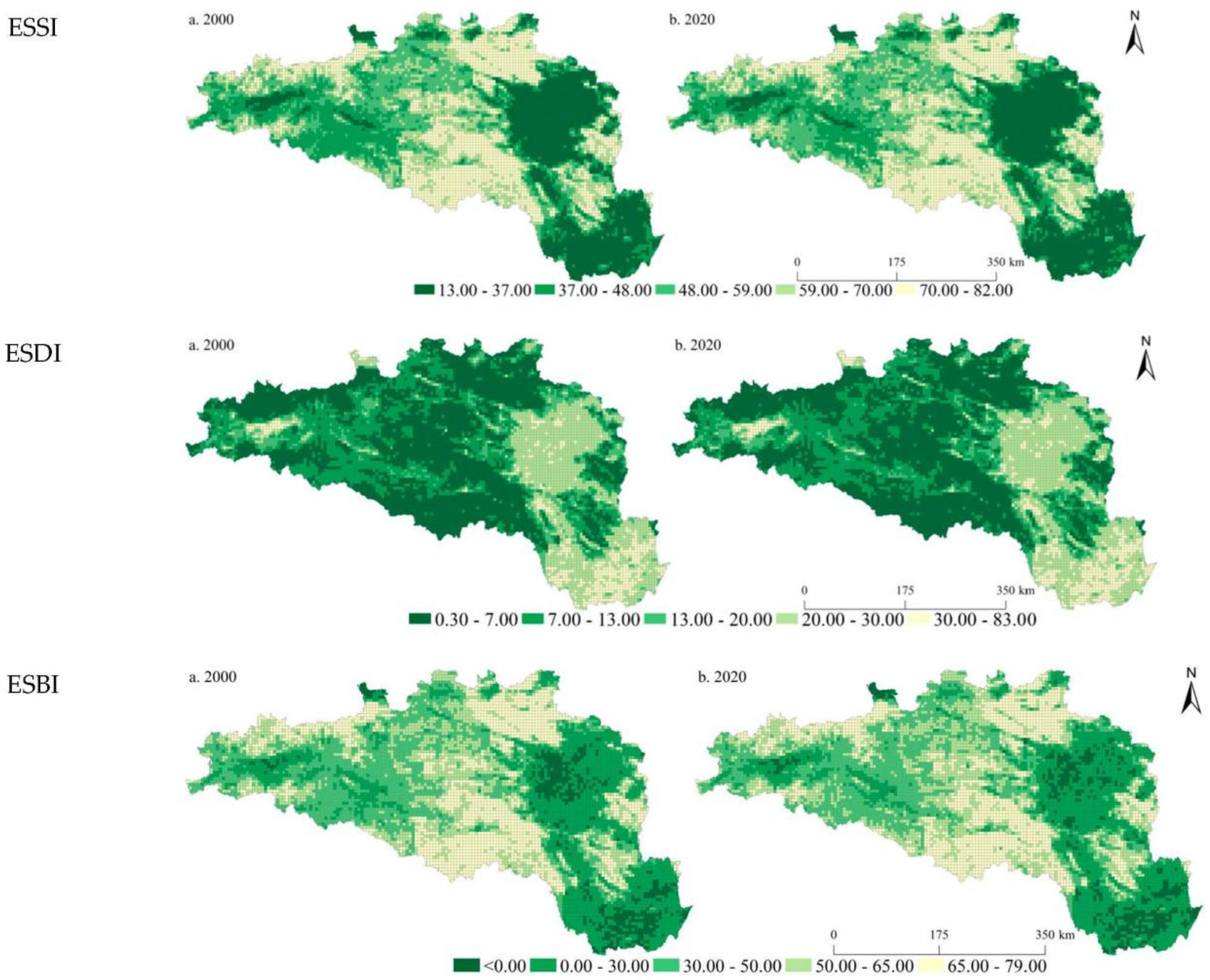
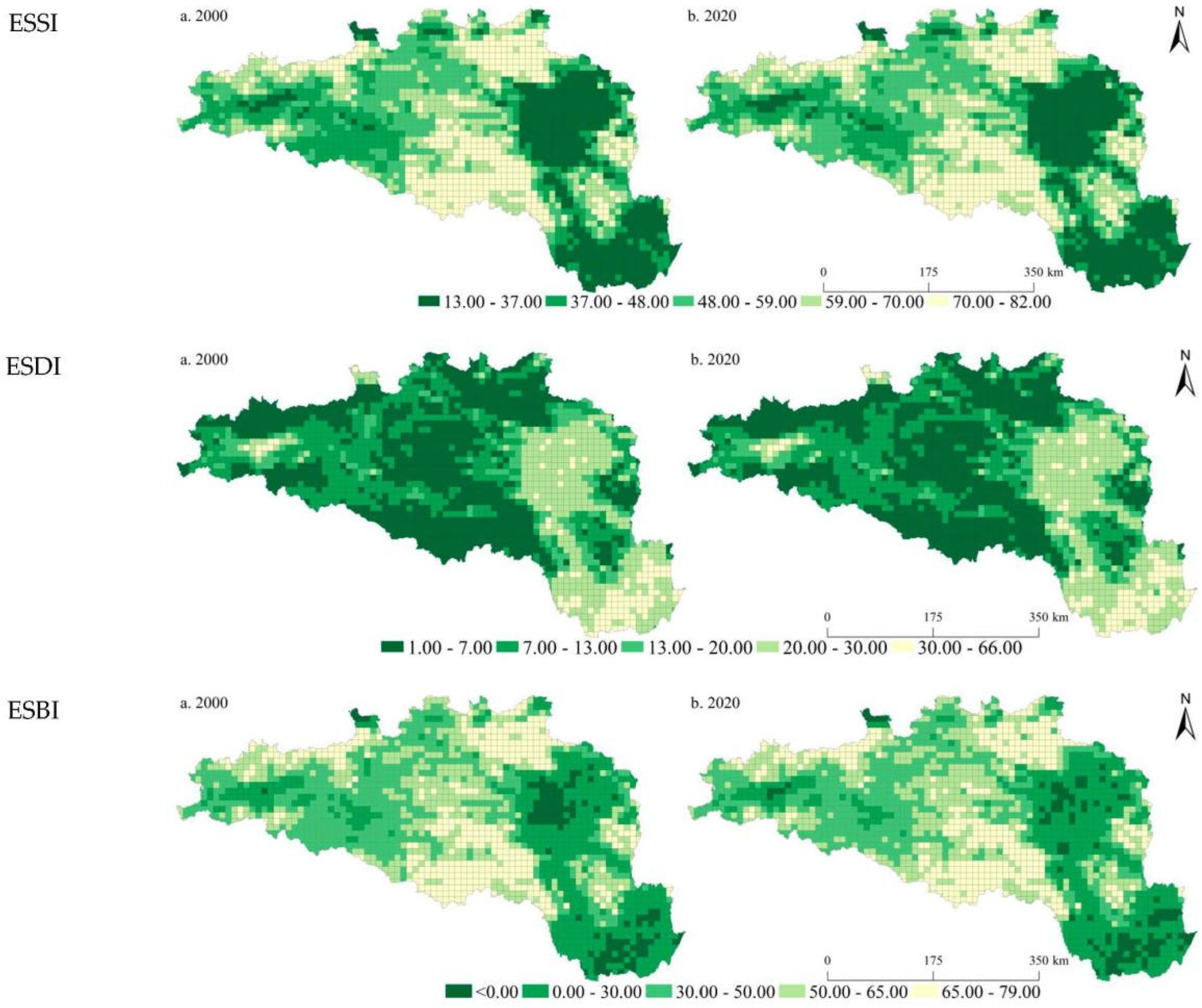
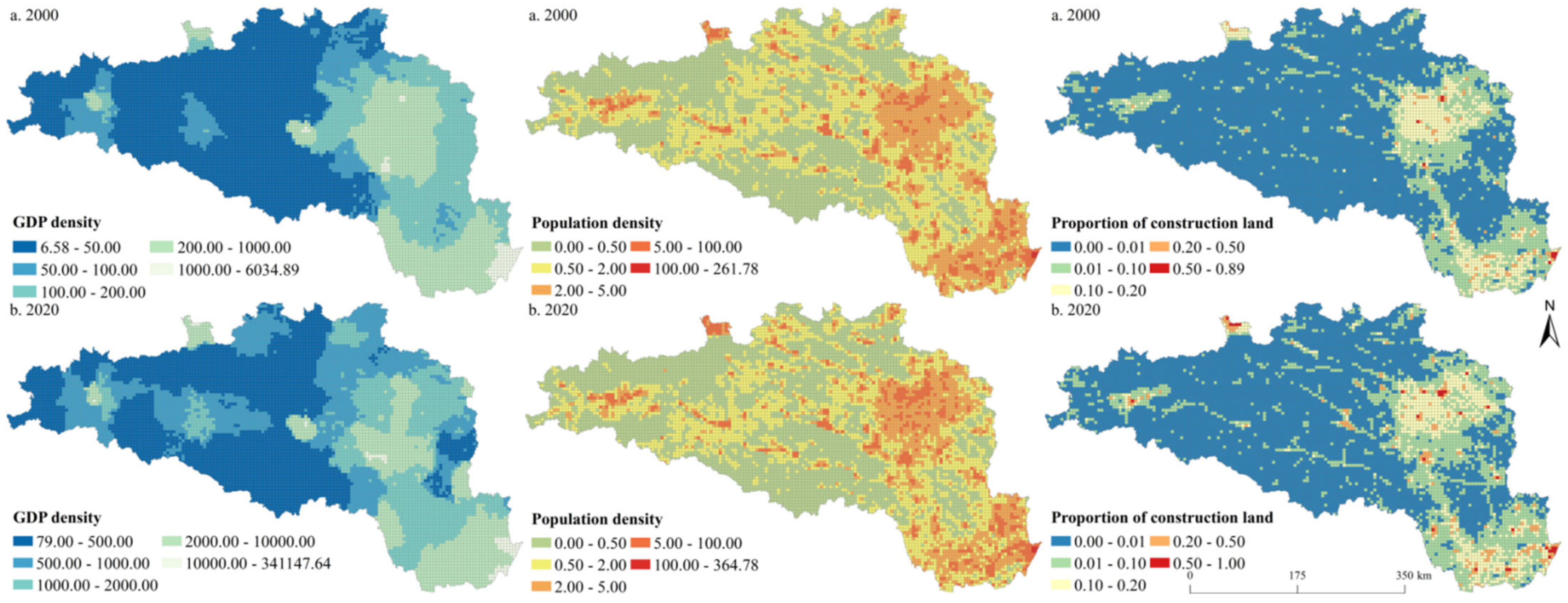
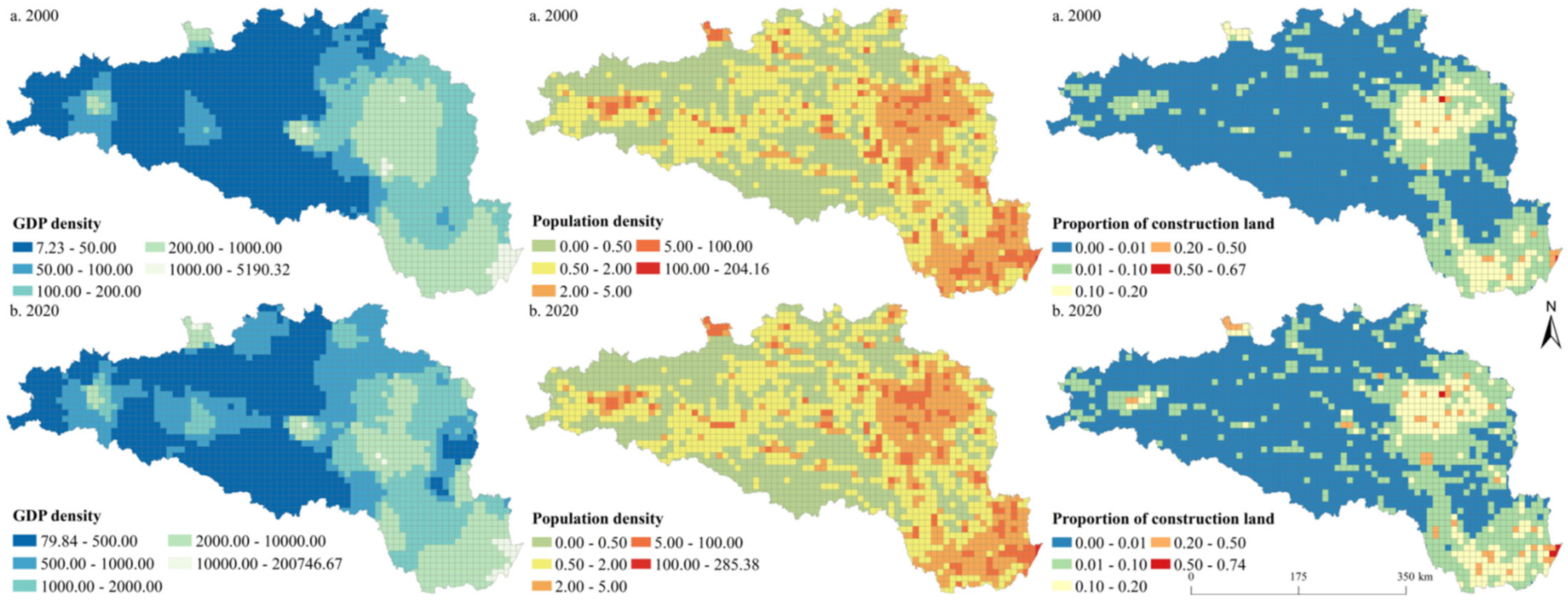
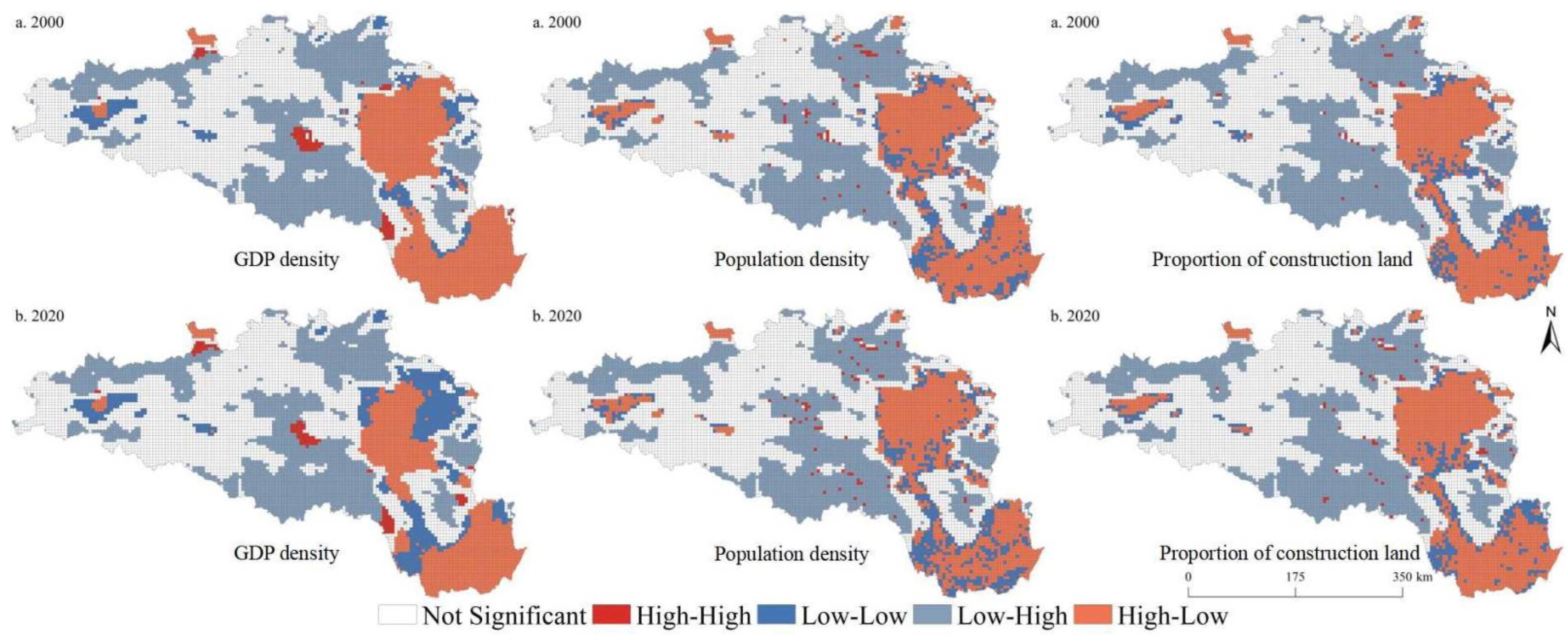
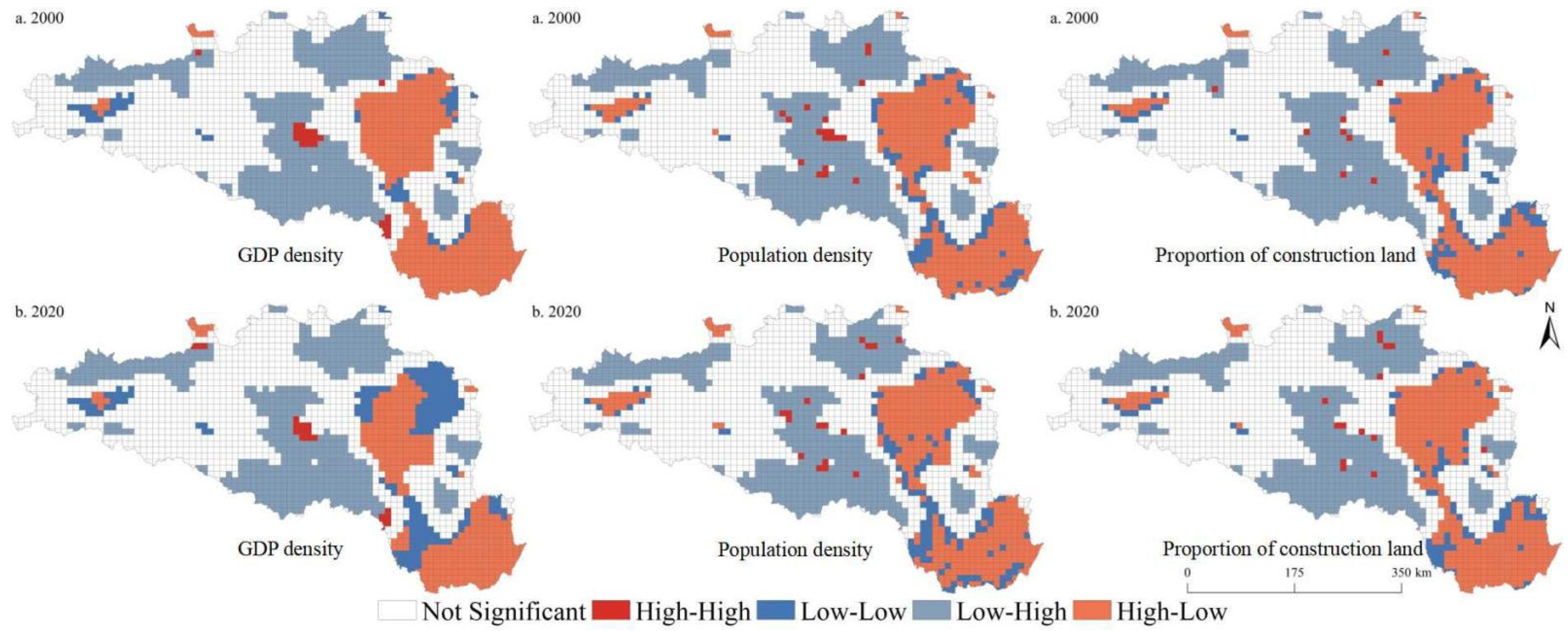
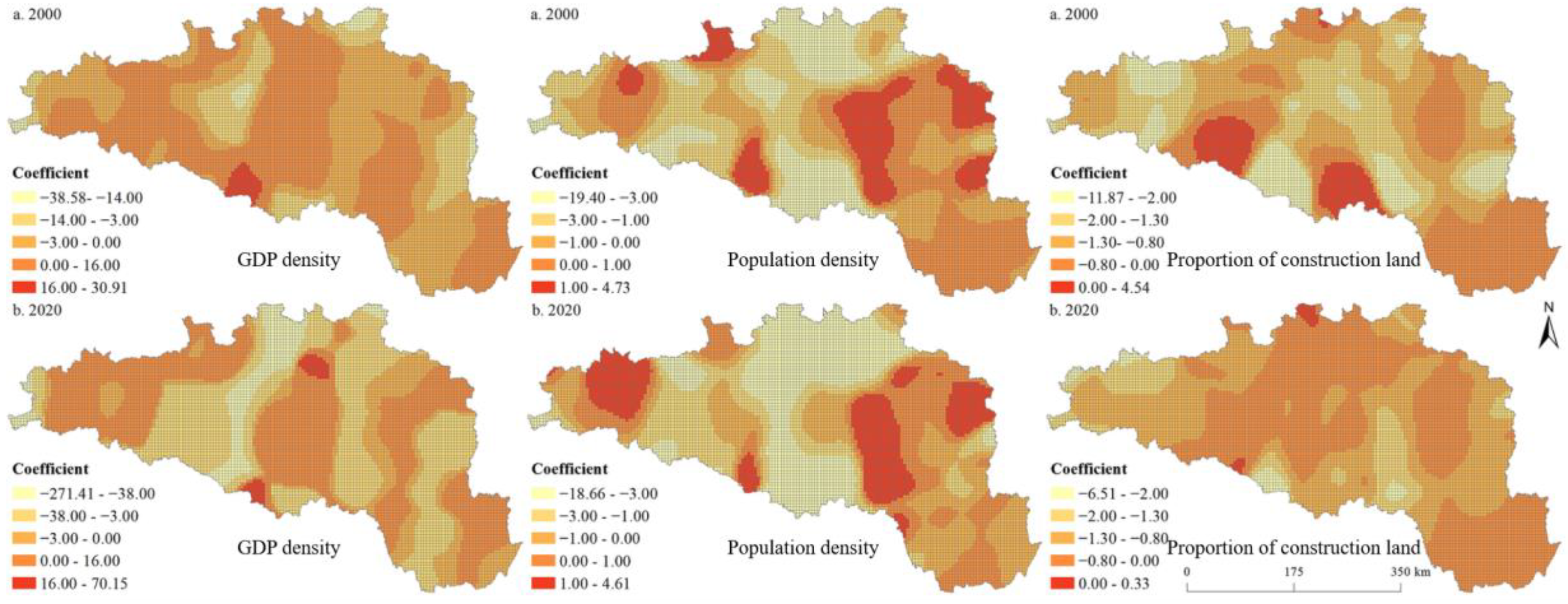
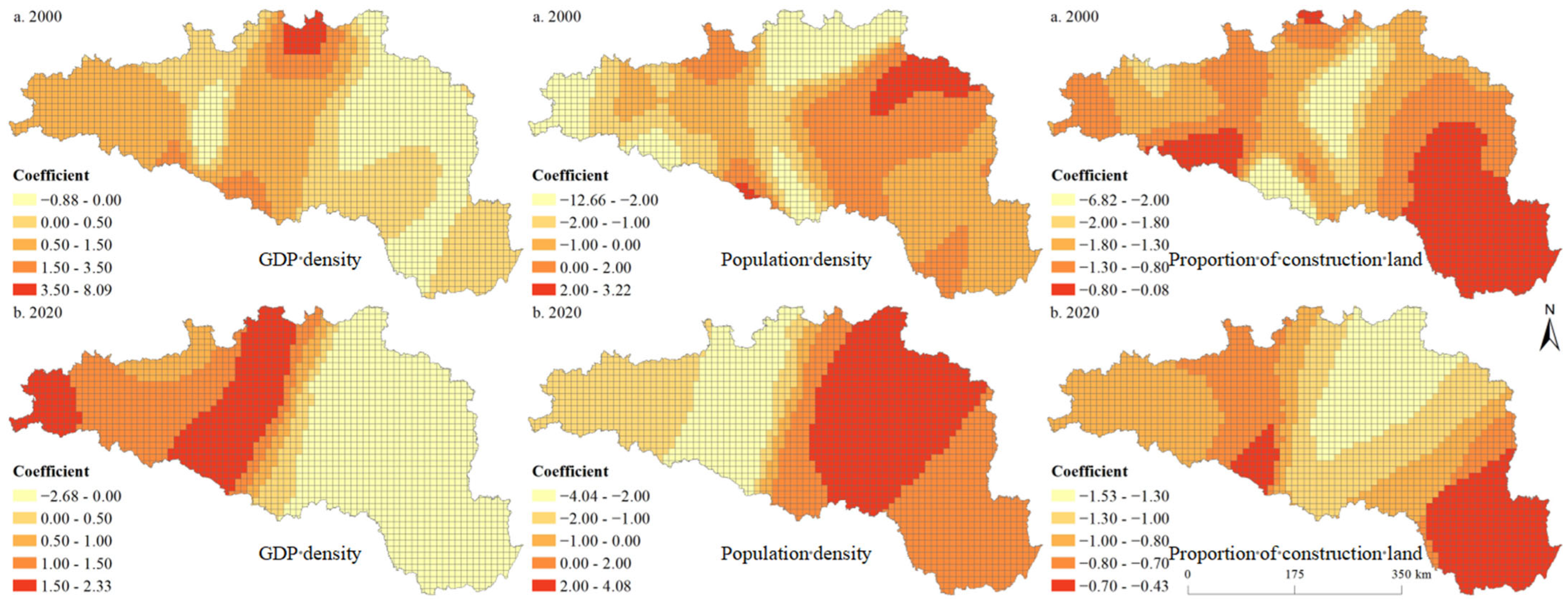
| Variable | 2000 | 2020 | ||||||
|---|---|---|---|---|---|---|---|---|
| Coefficient | Standardized Coefficients | Sig. | VIF | Coefficient | Standardized Coefficients | Sig. | VIF | |
| Intercept | 0.691 | 0.004 | 0.000 | 0.649 | 0.004 | 0.000 | ||
| Proportion of construction land | −1.588 | 0.029 | 0.000 | 2.125 | −1.243 | 0.021 | 0.000 | 1.915 |
| Population density | 0.856 | 0.079 | 0.000 | 2.004 | 0.710 | 0.100 | 0.000 | 3.071 |
| GDP density | −0.020 | 0.037 | 0.730 | 1.973 | −0.091 | 0.074 | 0.000 | 2.262 |
| Elevation | 0.353 | 0.007 | 0.000 | 1.366 | 0.396 | 0.007 | 0.000 | 1.636 |
| Land use intensity | −0.016 | 0.005 | 0.000 | 1.108 | 0.001 | 0.004 | 0.707 | 1.097 |
| Precipitation | −0.018 | 0.008 | 0.012 | 1.171 | 0.093 | 0.006 | 0.000 | 3.070 |
| Variable | 2000 | 2020 | ||||||
|---|---|---|---|---|---|---|---|---|
| Coefficient | Standardized Coefficients | Sig. | VIF | Coefficient | Standardized Coefficients | Sig. | VIF | |
| Intercept | 0.763 | 0.010 | 0.000 | 0.731 | 0.010 | 0.000 | ||
| Proportion of construction land | −1.403 | 0.053 | 0.000 | 2.486 | −1.034 | 0.035 | 0.000 | 2.119 |
| Population density | 0.701 | 0.074 | 0.000 | 2.337 | 0.594 | 0.141 | 0.003 | 3.012 |
| GDP density | 0.053 | 0.073 | 0.527 | 2.630 | −0.081 | 0.083 | 0.395 | 2.470 |
| Elevation | 0.309 | 0.013 | 0.000 | 1.458 | 0.307 | 0.013 | 0.000 | 1.958 |
| Land use intensity | −0.298 | 0.014 | 0.000 | 1.380 | −0.257 | 0.013 | 0.000 | 1.425 |
| Precipitation | −0.090 | 0.014 | 0.000 | 1.175 | 0.036 | 0.011 | 0.000 | 1.612 |
| Scale/Year | 2000 | 2020 | ||
|---|---|---|---|---|
| 5 km grid scale | Variable name | Variable | Variable name | Variable |
| Bandwidth | 35,386.88 | Bandwidth | 35,386.88 | |
| Residual Squares | 12.44 | Residual Squares | 9.37 | |
| Effective Number | 176.98 | Effective Number | 197.12 | |
| Sigma | 0.06 | Sigma | 0.05 | |
| AICc | −11,394.77 | AICc | −13,977.34 | |
| R2 | 0.89 | R2 | 0.88 | |
| R2Adjusted | 0.89 | R2Adjusted | 0.87 | |
| 10 km grid scale | Bandwidth | 68,965.89 | Bandwidth | 157,468.11 |
| Residual Squares | 6.67 | Residual Squares | 10.34 | |
| Effective Number | 95.50 | Effective Number | 35.95 | |
| Sigma | 0.06 | Sigma | 0.07 | |
| AICc | −4669.99 | AICc | −5116.64 | |
| R2 | 0.92 | R2 | 0.86 | |
| R2Adjusted | 0.91 | R2Adjusted | 0.86 | |
| Variable | 2000 | 2020 | ||||||||||||||
|---|---|---|---|---|---|---|---|---|---|---|---|---|---|---|---|---|
| Min | Lower Quantile | Median | Upper Quantile | Max | Mean | Negative Ratio | Positive Ratio | Min | Lower Quantile | Median | Upper Quantile | Max | Mean | Negative Ratio | Positive Ratio | |
| Proportion of construction land | −11.87 | −1.56 | −1.06 | −0.65 | 4.54 | −1.20 | 0.93 | 0.07 | −6.50 | −1.08 | −0.80 | −0.58 | 0.33 | −0.88 | 0.99 | 0.01 |
| Population density | −19.40 | −2.21 | −0.35 | 0.39 | 4.72 | −1.23 | 0.58 | 0.42 | −18.66 | −3.10 | −0.51 | 0.41 | 4.61 | −1.53 | 0.65 | 0.35 |
| GDP density | −38.57 | −1.01 | −0.02 | 0.51 | 30.90 | −0.40 | 0.51 | 0.49 | −271.41 | −9.82 | −0.64 | 1.28 | 70.15 | −9.17 | 0.57 | 0.43 |
| Elevation | −9.74 | 0.34 | 0.58 | 1.87 | 5.19 | 1.16 | 0.05 | 0.95 | −8.35 | 0.28 | 0.51 | 1.64 | 4.91 | 1.03 | 0.04 | 0.96 |
| Land use intensity | −1.55 | −0.02 | 0.00 | 0.00 | 0.04 | −0.09 | 0.68 | 0.32 | −1.50 | −0.02 | 0.00 | 0.00 | 0.03 | −0.09 | 0.65 | 0.35 |
| Precipitation | −1.62 | −0.22 | 0.03 | 0.33 | 1.39 | 0.06 | 0.47 | 0.53 | −1.96 | −0.10 | 0.11 | 0.41 | 5.61 | 0.16 | 0.34 | 0.66 |
| Variable | 2000 | 2020 | ||||||||||||||
|---|---|---|---|---|---|---|---|---|---|---|---|---|---|---|---|---|
| Min | Lower Quantile | Median | Upper Quantile | Max | Mean | Negative Ratio | Positive Ratio | Min | Lower Quantile | Median | Upper Quantile | Max | Mean | Negative Ratio | Positive Ratio | |
| Proportion of construction land | −6.82 | −1.60 | −1.22 | −0.75 | −0.08 | −1.25 | 1.00 | 0.00 | −1.53 | −1.17 | −0.91 | −0.75 | −0.42 | −0.96 | 1.00 | 0.00 |
| Population density | −12.66 | −1.55 | −0.22 | 0.27 | 3.21 | −0.81 | 0.67 | 0.33 | −4.03 | −1.81 | 0.37 | 2.24 | 4.08 | 0.31 | 0.39 | 0.61 |
| GDP density | −0.87 | −0.02 | 0.22 | 0.90 | 8.08 | 0.55 | 0.27 | 0.73 | −2.67 | −0.37 | −0.05 | 1.32 | 2.32 | 0.29 | 0.51 | 0.49 |
| Elevation | −0.20 | 0.31 | 0.58 | 1.10 | 4.19 | 0.92 | 0.04 | 0.96 | 0.09 | 0.26 | 0.40 | 0.56 | 1.55 | 0.44 | 0.00 | 1.00 |
| Land use intensity | −0.89 | −0.41 | −0.18 | −0.06 | 0.05 | −0.26 | 0.99 | 0.01 | −0.66 | −0.47 | −0.20 | −0.10 | −0.06 | −0.28 | 1.00 | 0.00 |
| Precipitation | −1.38 | −0.19 | 0.00 | 0.14 | 0.81 | −0.04 | 0.50 | 0.50 | −0.32 | −0.08 | 0.03 | 0.16 | 0.39 | 0.04 | 0.45 | 0.55 |
Publisher’s Note: MDPI stays neutral with regard to jurisdictional claims in published maps and institutional affiliations. |
© 2022 by the authors. Licensee MDPI, Basel, Switzerland. This article is an open access article distributed under the terms and conditions of the Creative Commons Attribution (CC BY) license (https://creativecommons.org/licenses/by/4.0/).
Share and Cite
Li, W.; Chen, W.; Bian, J.; Xian, J.; Zhan, L. Impact of Urbanization on Ecosystem Services Balance in the Han River Ecological Economic Belt, China: A Multi-Scale Perspective. Int. J. Environ. Res. Public Health 2022, 19, 14304. https://doi.org/10.3390/ijerph192114304
Li W, Chen W, Bian J, Xian J, Zhan L. Impact of Urbanization on Ecosystem Services Balance in the Han River Ecological Economic Belt, China: A Multi-Scale Perspective. International Journal of Environmental Research and Public Health. 2022; 19(21):14304. https://doi.org/10.3390/ijerph192114304
Chicago/Turabian StyleLi, Weisong, Wanxu Chen, Jiaojiao Bian, Jun Xian, and Li Zhan. 2022. "Impact of Urbanization on Ecosystem Services Balance in the Han River Ecological Economic Belt, China: A Multi-Scale Perspective" International Journal of Environmental Research and Public Health 19, no. 21: 14304. https://doi.org/10.3390/ijerph192114304
APA StyleLi, W., Chen, W., Bian, J., Xian, J., & Zhan, L. (2022). Impact of Urbanization on Ecosystem Services Balance in the Han River Ecological Economic Belt, China: A Multi-Scale Perspective. International Journal of Environmental Research and Public Health, 19(21), 14304. https://doi.org/10.3390/ijerph192114304







